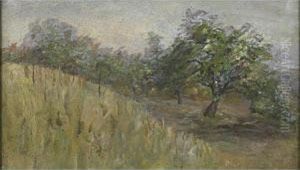Jane Byrd Mccall Whitehead Paintings
Jane Byrd McCall Whitehead, born in 1861, was an influential figure in the American Arts and Crafts Movement, an aesthetic movement that emerged in the late 19th and early 20th centuries, emphasizing craftsmanship and design. Jane's contributions to the movement were marked by her advocacy for handcrafted goods and her efforts to establish communities that lived by the principles of simplicity, beauty, and functionality in their daily lives and work.
Jane Byrd McCall was born into a well-to-do family in Philadelphia, Pennsylvania. Her upbringing in a Quaker household instilled in her the values of simplicity and utility, which would later influence her work in the Arts and Crafts Movement. In 1886, she married Ralph Radcliffe Whitehead, a British man who shared her passion for the Arts and Crafts philosophy. Together, they sought to create a utopian community that would embody the ideals of the movement.
In 1902, the Whiteheads founded Byrdcliffe, an Arts and Crafts colony in Woodstock, New York. Byrdcliffe became a haven for artists, craftspeople, and writers, providing a space where they could work and live according to the principles of the Arts and Crafts Movement. The colony offered workshops in woodworking, metalwork, weaving, and pottery, and emphasized the importance of creating objects that were both beautiful and functional. Byrdcliffe also became a significant cultural center, attracting notable figures of the time and fostering a creative community that thrived on collaboration and artistic freedom.
Jane Byrd McCall Whitehead's role in the establishment and success of Byrdcliffe was crucial. She was deeply involved in the design and operation of the colony, from the layout of the buildings to the details of the craft workshops. Her vision for a community that integrated art into everyday life was realized in Byrdcliffe, which remains an active center for the arts to this day.
Throughout her life, Jane Byrd McCall Whitehead remained a staunch advocate for the Arts and Crafts Movement. After Ralph's death in 1929, she continued to promote the ideals of the movement and oversee the operation of Byrdcliffe. She passed away in 1955, leaving behind a legacy of artistic and cultural influence that continues to inspire those who value craftsmanship and design. Her contributions to the American Arts and Crafts Movement and her role in founding one of its most enduring communities have cemented her place in art history as a pioneering figure.
